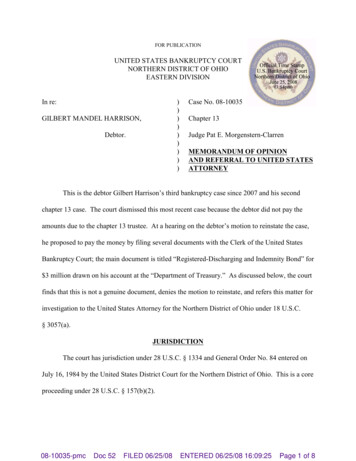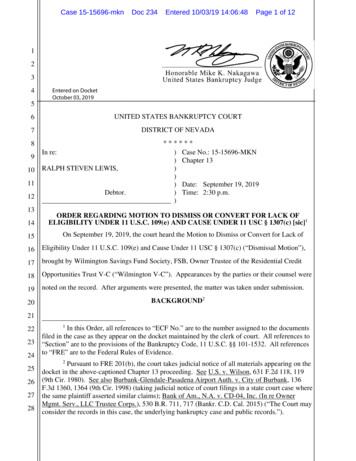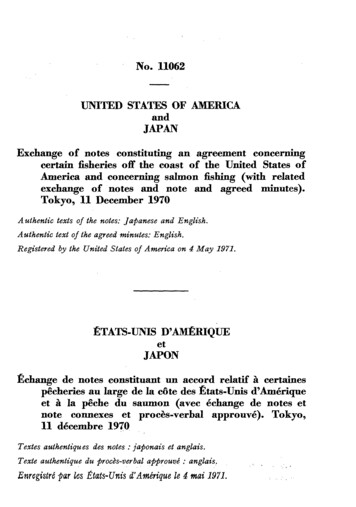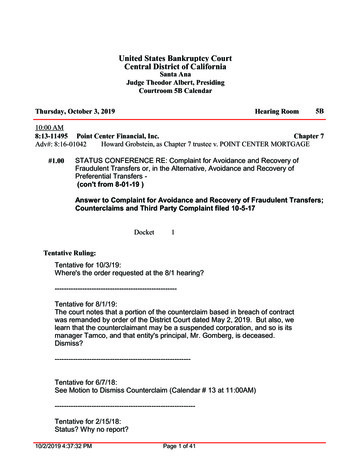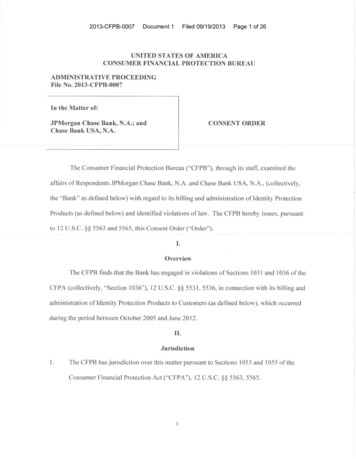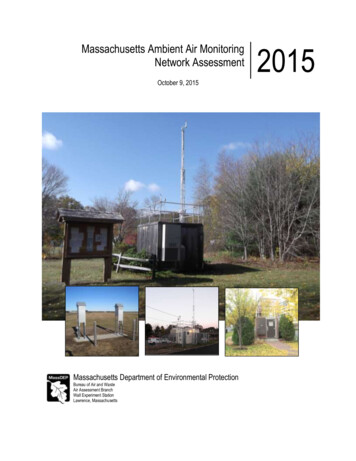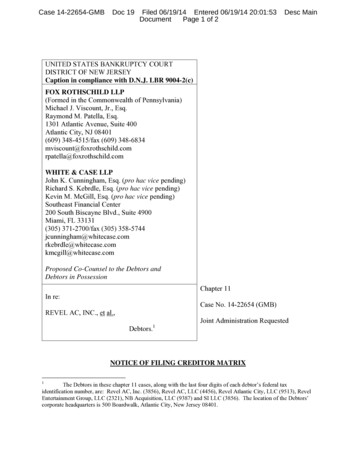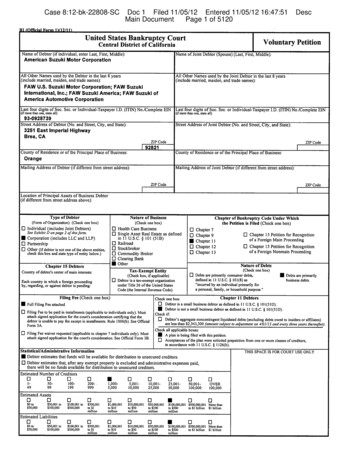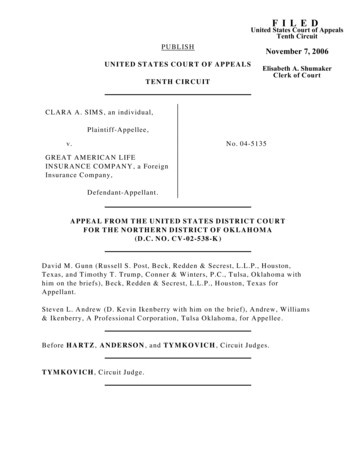
Transcription
F IL E DUnited States Court of AppealsTenth CircuitPUBLISHNovember 7, 2006U N IT E D ST A T E S C O U R T O F A PP E A L SElisabeth A. ShumakerClerk of CourtT E N T H C IR C U ITCLARA A. SIM S , an individual,Plaintiff-Appellee ,v.No. 04-5135GREAT A M ERICA N LIFEINSU RANCE COM PA NY , a ForeignInsurance Com pany,Defendant-Appellant .A PPE A L FR O M T H E U N IT ED ST A T ES D IST R IC T C O U R TFO R T H E N O R T H E R N D IST R IC T O F O K L A H O M A(D .C . N O . C V -02-538-K )David M . Gunn (Russell S. Post, Beck, Redden & Secrest, L.L.P., Houston,Texas, and Timothy T. Trum p, Conner & W inters, P.C., Tulsa, Oklahom a withhim on the briefs), Beck, Redden & Secrest, L.L.P., Houston, Texas forAppellant.Steven L. A ndrew (D . K evin Ikenberry w ith him on the brief), A ndrew , W illiam s& Ikenberry, A Professional Corporation, Tulsa Oklahoma, for Appellee .Before H A R T Z , A N D ER SO N , and T Y M K O V IC H , Circuit Judges.T Y M K O V IC H , Circuit Judge.
Lawrence Sims died when the speeding car he was driving sailed off a ruralroad. Prior to his untimely death, he had obtained life insurance from GreatAmerican Life Insurance Company. Sims’s wife made a claim on this policy, butafter an investigation Great American denied the claim under its non-accidentaldeath provision concluding that Sims committed suicide. M rs. Sims then filedsuit against G reat American alleging breach of contract and bad faith for itsfailure to pay her husband’s life insurance policy. A jury found the death wasaccidental and awarded M rs. Sims 1.4 million in compensatory and punitivedamages. Great American argues on appeal that the district court made numerousevidentiary and procedural errors when it precluded Great American fromintroducing relevant evidence pertaining to the crash and Sims’s state of mind atthe time of his death.This case requires us to consider the interplay between the Erie doctrineand the Federal Rules of Evidence in diversity cases tried in federal district court.The district court refused to adm it evidence that would have been inadm issible instate court, concluding that state policy trum ps the Federal Rules of Evidence.Although we conclude that the Erie doctrine does not govern the admissibility ofevidence under the Federal Rules, we find that the Rules still require diversitycourts to analyze substantive state policy in considering the admissibility ofevidence.-2-
Exercising jurisdiction under 28 U.S.C. § 1291, we REVERSE the districtcourt’s denial of judgment as a matter of law on both the bad faith and punitivedamages claims. W e otherwise AFFIRM .I. BackgroundA . Law rence Sim s’s D eathOn September 3, 2001, Lawrence and Clara Sims attended a golftournament at their local country club. Sims became extremely intoxicated duringthe course of the day. He was still quite intoxicated when the couple returnedhome that evening to an unkempt kitchen. Over this seemingly minor issue, Simsexpressed unexpected agitation and anger in front of his wife and daughter. Hestormed out of the kitchen, jumped in his car, and sped away.Concerned for her husband’s well-being, M rs. Sims immediately called911. She told the 911 operator that Sims “was upset and that we were afraid thathe was going to get hurt or hurt himself.” R. at 807. By the next morning whenher husband had still failed to return home, M rs. Sims phoned family, friends, andlocal hospitals to no avail. She then filed a missing persons report. In her sw ornstatement to the police, she described Sims’s state of mind on the evening ofSeptember 3:Drinking— but in a good mood. Got home around 9:00, got angrybecause the house was a mess . . . Got angrier [and] angrier— slammeddining room chair to floor [and] stormed out— saying he’s “out of here.”M entioning driving off a cliff. Called 911 to let you know.-3-
R. at 85. The official missing persons report, drafted by the police and signed byM rs. Sims without her review, editorialized on this language, noting instead that“M r. Sims was enraged over the cleanliness of their home . . . [and] may besuicidal, because when he left his residence, M r. Sims mentioned something aboutdriving off a cliff.” R. at 84 (emphasis added).Two days later police recovered Sims’s body. Based on evidence at theaccident scene, police surmised that his car had careened off the main road onto aright-of-way toward a creek. The car, traveling at an excessively high rate ofspeed, clipped a fence and then hit a bump that caused it to sail some 115 feetover a creek bed, before landing in a pasture. No skid marks were visible at thescene nor any other evidence suggesting that Sims swerved before clipping thefence. Although Sims habitually wore his seat belt, on this occasion his seat beltwas not fastened. Post-mortem examination revealed a blood-alcohol content(B AC) of 0.19% , well over the legal limit.Despite M rs. Sims’s sworn police statement to the contrary, she hassteadfastly held in these proceedings that she intentionally lied about herhusband’s intent to drive off a cliff. This lie, she claims, was merely an effort toencourage the police to act quickly to locate her missing husband. M rs. Simsadamantly asserts that she never believed her husband was truly suicidal.-4-
B . Life Insurance Investigation and D enial of C laimIn August 2000, Sims obtained a life insurance policy from Great Americanin the amount of 300,000. This policy expressly excluded recovery for nonaccidental death. Following Sims’s death, M rs. Sims made a claim.As w as its typical practice, Great American hired an independent claiminvestigator, Broyles Claim Service Agency, to review the claim. Broylesexamined a number of documents as part of its investigation, including (1) themissing persons report, (2) the accident report, (3) the medical examiner’s report,(4) the death certificate, and (5) Sims’s medical and pharmaceutical records.Additionally, Broyles conducted telephone interviews with the m edical examiner,the investigating police officer, M rs. Sims, and M rs. Sims’s counsel.Both the police department accident report and the county’s deathcertificate listed suicide as the manner of death. The investigating officer and thecoroner relied heavily on the missing persons report in making their cause ofdeath determination. In preparing the accident report, for example, theinvestigating officer reviewed the missing persons report as well as the physicalcircumstances of the accident. But the officer conceded at trial that he had neverexamined the car to determine if the brakes failed or showed other mechanicaldeficiencies which could have caused a loss of control. Although the officer did-5-
not know Sims’s BAC when he originally prepared the report, he was adamantthat he would still have listed suicide as the cause of death.The medical examiner also attributed the death to suicide. However, themedical examiner did not perform an autopsy to determine if Sims suffered astroke or exhibited symptoms of some other ailment that could have caused him tolose consciousness or control of the vehicle. W hen asked by Broyles why heruled the death a suicide, the medical examiner replied “that if [Broyles had seenthe] missing persons report and the accident report, we would see the reason forhis [conclusion].” R. at 1764.Broyles also obtained a recorded statement from M rs. Sims, with hercounsel present, and a separate statement from counsel as he had known Simsfrom the country club. Unsurprisingly, both parties insisted that Sims did notcomm it suicide. W hile M rs. Sims did not explicitly recant her sworn policestatement until after filing this law suit, Broyles never asked why her sw ornstatement contradicted her statement to him. Nor did Broyles question M rs. Simsregarding any possible motive Sims had to commit suicide. Broyles’sinvestigation revealed that Sims’s medical and pharmaceutical records showed noindication of mental depression.Finally, M rs. Sims claims Broyles was aware that another officer involvedat the scene believed Sims’s crash was accidental. Broyles denies this charge.-6-
But in any event, Broyles did not interview this officer or any other officer withthe exception of the investigating officer. Broyles never interviewed Sims’sdaughter, w ho saw him the night of the incident.Based on this investigation, Broyles recommended that Great Americandeny accidental life insurance coverage and pay the claim under the suicideprovision. Two agents of Great American reviewed this recommendation andconcurred, tendering a return of the policy premiums that had been paid todate— 2,964.67.C . Proceedings in D istrict C ourtFollowing the denial of the insurance claim, M rs. Sims filed suit in federalcourt, alleging both breach of contract and bad faith. The district court deniedGreat American’s summary judgment motion on the bad faith claim and similarlydenied Great American’s motion for judgment as a matter of law at the close ofthe trial. The jury awarded M rs. Sims 300,000 for the breach of contract claim, 600,000 for the bad faith claim, and 500,000 in punitive damages. Followingthe verdict, Great American renewed its motion for judgment as a matter of lawor, in the alternative, a new trial, which the district court rejected. GreatAmerican’s timely appeal is now before this court.II. A nalysis-7-
On appeal, Great American asserts that the district court comm ittednumerous errors, each constituting grounds for reversal:(1) the court improperly excluded relevant evidence underOklahoma’s seat belt law that would have helped support the defensetheory that Sims was suicidal on the night of the crash;(2) the court should have admitted evidence that the coroner andinvestigating officer believed Sims’s death a suicide;(3) the court erred in excluding evidence of Sims’s father’s suicide;(4) the jury’s finding of bad faith and punitive damages was notsupported by sufficient evidence at trial; and(5) the court should have permitted Great American’s accidentreconstruction expert to testify at trial. 1A . Evidentiary C laim sAt the heart of Great American’s appeal is its argument that the FederalRules of Evidence govern questions of admissibility in federal diversity cases,irrespective of the existence of conflicting state statutes. This argument rests onthe proposition that the doctrine set forth in Erie R.R. v. Tom pkins, 304 U.S. 64(1938), is inapplicable to these Rules. Based on this premise, Great Americanasserts that the district court improperly applied state law, as opposed to the1Great American also argued that one of the court’s jury instructionsimproperly characterized bad faith as a negligent tort. At oral argument, GreatAmerican conceded that the Oklahoma Supreme Court recently ruled to thecontrary and approvingly cited to the jury instruction used by the district courtbelow. See Badillo v. M id Century Ins. Co., 121 P.3d 1080, 1093 (Okla. 2005).Accordingly, we need not address this argument.-8-
Federal Rules of Evidence, to exclude (1) evidence showing Sims failed to wearhis seat belt on the night he died, as well as (2) reports and testimony from stateofficials concerning Sims’s manner of death.W e are persuaded that the Federal Rules of Evidence are not governed bythe Erie doctrine. Having said that, concepts of federalism still guide ourunderstanding of the interplay between the Federal Rules and state law. Althoughwe do not ground our holding in Erie, we conclude that state substantive policydirects the admissibility of evidence under the relevancy considerations of Rule401.1. E rie and F ederal R ules of E videnceThis case presents us with a classic civil procedure question— in the face ofa conflicting state statute, w hen does a federal court sitting in diversity applyfederal law? This question, of course, invokes the Supreme Court’s seminaldecision in Erie Railroad v. Tom pkins and the landmark trilogy which followed.See G uar. Trust Co. v. York, 326 U.S. 99 (1945) (creating the outcomedetermination test); Byrd v. Blue Ridge Rural Elec. Coop., 356 U.S. 525 (1958)(holding that the outcome determination test is not dispositive in the face ofcountervailing federal interests); Hanna v. Plumer, 380 U.S. 460 (1965) (holdingErie inapplicable to the Federal Rules of Civil Procedure). Collectively, the“broad command” flowing from these cases requires federal courts “to apply state-9-
substantive law and federal procedural law.” Hanna, 380 U.S. at 465. However,the sw eep of this broad command is limited— only federal common law isgoverned by the Erie doctrine; congressional acts and the Federal Constitutionfall outside its scope. As the Erie court famously stated:Except in matters governed by the Federal C onstitution or by acts ofCongress, the law to be applied in any case is the law of the state. . . . There is no federal general common law. Congress has no powerto declare substantive rules of common law applicable in a statewhether they be local in their nature or “general,” be they commerciallaw or a part of the law of torts.Erie, 304 U.S. at 78 (emphasis added). This seemingly sim ple rule, however, hasa surprisingly complex application when the federal rule at issue is one of theFederal Rules of Evidence.Great Am erican argues that the Federal Rules of Evidence are an “act ofCongress,” not federal com m on law, and therefore outside the purview of Erie.Accordingly, when applying these Rules, Great Am erican continues, federaldiversity courts should not look to Erie but instead should apply the testform ulated in Stewart Org., Inc. v. Ricoh Corp., 487 U.S. 22 (1988), whichgoverns the application of a federal statute to a diversity case. FollowingStewart, a court asks whether the evidentiary rule is both (1) “sufficiently broadto control the issue before the Court,” and (2) “a valid exercise of Congress’authority under the Constitution.” Id. To be a valid exercise of congressionalauthority, the federal rule m ust be “capable of classification” as a procedural rule.-10-
Id. at 32 (quoting Hanna, 380 U .S. at 472). If the rule satisfies both conditions,absent other considerations, the federal evidentiary rule applies. See id. at 26(noting that a “district court’s decision whether to apply a federal statute . . . in adiversity action . . . involves a considerably less intricate analysis than that whichgoverns the ‘relatively unguided Erie choice’”) (quoting Hanna, 380 U.S. at 471).A brief review of the origins of the Federal Rules of Evidence shows thatStewart provides the starting point in determining the admissibility of evidence inthis case.a. Origin of Federal Rules of EvidenceGreat American’s argument rises or falls on the premise that the FederalRules of Evidence are a product of congressional action. Our review of therelevant history reveals this to be so.Prior to the enactment of the Federal Rules of Evidence, Federal Rule ofCivil Procedure 43(a) governed evidentiary matters in federal courts. 19 CharlesAlan W right, Arthur R. M iller & Edward H. Cooper, Federal Practice andProcedure § 4512 (2d ed. 1996 & Supp. 2005) (“Federal Practice”). Under Rule43, federal courts typically applied state evidentiary law to questions regardingthe admissibility of evidence. Id. (“[T]he norm was to follow forum state law onevidentiary matters, not because Erie demanded it, but simply because the Civil-11-
Rule so directed.”). But in 1972, the Supreme Court started drafting anindependent set of rules governing the admissibility of evidence in federal courts:the Federal Rules of Evidence.At the time the Supreme Court was considering the Rules of Evidence,Congress passed a statute requiring congressional approval before the Court couldpromulgate not only these Rules but also amendments that had been proposed in1972 to the already promulgated Federal Rules of Civil and Criminal Procedure.See Act of M arch 30, 1973, Pub. L. No. 93-12, 87 Stat. 9. Congress’s concern, inlarge part, was based on a desire to protect substantive state law. 19 FederalPractice § 4512. In this way, Congress became intricately involved in formulatingthe Federal Rules of Evidence, and the Rules themselves became an act ofCongress. 2 See Act of Jan. 2, 1975, Pub. L. No. 93-595, 88 Stat. 1926.Remembering that Erie limits its holding to federal common law and excepts2The Act of M arch 30, 1973 required congressional approval only for theSupreme Court orders in late 1972. Those orders proposed the original FederalRules of Evidence as well as certain amendments to both the Federal Rules ofCivil Procedure and the Federal Rules of Criminal Procedure. Congress did notextend this Act to apply to all future amendments of the Federal Rules. Instead,under the current system, amendments are made pursuant to a process whereby theSupreme Court approves a change to the Rules and notifies Congress of suchchange. If Congress fails to act, the amended rule goes into effect. In short,since 1975, amendments to the Federal Rules have not been promulgated by an actof Congress. As discussed below, our analysis focuses on Rule 401. Because thisRule has remained unamended since 1975, we need not analyze the effect of Erieon evidentiary rules amended since that time.-12-
congressional actions, this history makes clear that Erie does not apply to theoriginal Federal Rules of Evidence.Nor can we find that Congress otherwise explicitly limited the applicabilityof the Federal R ules of Evidence in the face of conflicting state law. Twostatutes normally limit the effect of evidentiary and procedural rules, the RulesEnabling Act 3 and the Rules of Decision Act. 4 But these laws do not govern theFederal Rules of Evidence as originally enacted. 19 Federal Practice § 4512; seeFlaminio v. Honda M otor Co., 733 F.2d 463, 470 (7th Cir. 1984). The RulesEnabling Act proscribes the ability of the Supreme Court to alter substantiverights. Here, with the original enactment of the Federal Rules of Evidence, it wasCongress, not the Supreme Court, creating the Rules. Under the Rules ofDecision Act, state law provides for the rule of decision in civil cases exceptwhere Congress or the Constitution provides otherwise. Again, we are dealing3The Rules Enabling Act, granting the Supreme Court “the power toprescribe general rules of practice and procedure and rules of evidence for casesin” federal courts, simultaneously prohibits the Supreme Court from proscribingany rule of procedure or practice for cases in the federal courts that shall“abridge, enlarge or modify any substantive right.” 28 U.S.C. § 2072. This Acthas been used to limit the reach of the Federal Rules of Civil Procedure.4The Rules of Decision Act provides that state law, “except where theConstitution or treaties of the U nited States or Acts of Congress otherw ise requireor provide, shall be regarded as rules of decision in civil actions” in the federalcourts. 28 U.S.C. § 1652.-13-
with a congressional act. Put simply, there is nothing in these Acts that limits thescope of the Federal Rules of Evidence as originally enacted. 5In sum, because Erie does not apply to acts of Congress, thesubstance/procedure dichotomy embodied in that doctrine is inapplicable to theFederal Rules of Evidence as originally enacted. Further, because an act ofCongress is subject to neither the Rules Enabling Act nor the Rules of DecisionAct, these Acts do not work to limit the applicability of the unamended FederalRules of Evidence in the face of conflicting state law.b. Federal Court Application of Erie Doctrine to Federal Rules ofEvidenceW e recognize that numerous federal diversity courts have grappled withthis tricky issue and reached an opposite conclusion. These courts, such as thedistrict court below, suggest we limit application of the Federal Rules of Evidenceto those matters not implicating substantive state policy. See, e.g., M cInnis v.A.M .F., Inc., 765 F.2d 240, 245 (1st Cir. 1985); Szantay v. Beech Aircraft Corp.,349 F.2d 60, 63 (4th C
Lawrence Sims died when the speedi ng car he was driving sailed off a rural road. Prior to his untimely death, he had obt ained life insurance from Great American Li fe Insurance Company. Sims’s wife made a c laim on th
